So, once the goats have given birth, the big question is how soon to milk the goats after they 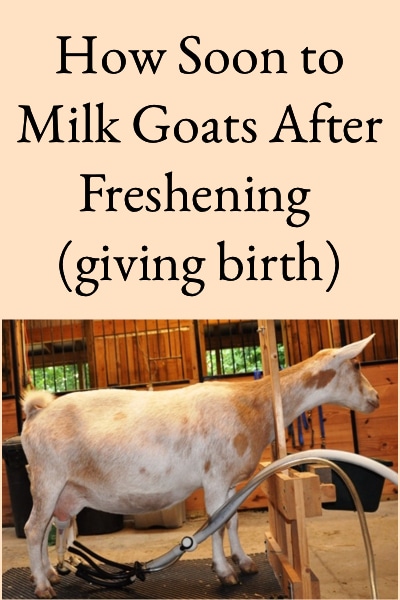
Our goats are Nigerian Dwarf goats (see Why You Should Choose Nigerian Dwarf Goats for Milk), which produce the highest butterfat milk of all dairy breed goats (around 6 – 10%), so their milk is incredibly good and makes awesome butter, ice cream, cheese, and yogurt. Obviously, we’d like to get that milk, but the goat kids’ welfare also needs to be considered.
Bottle Raising, Dam Raising, or Combination?
The question is how soon to milk the goats after they freshen and how to feed the kids – do you immediately pull all the kids from their dams and bottle feed them, do you let the dams raise them and wean the kids naturally, do you let the dams raise them for some period of time and then start separating them to get the milk, or do you use a combination of bottle feeding and dam feeding? Each approach has pros and cons:
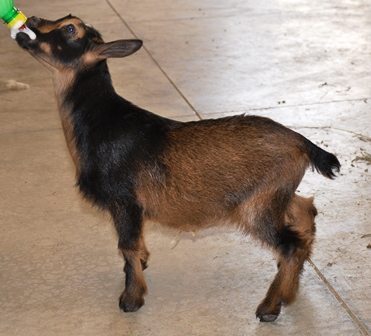
1) Bottle Raising:
If there’s any likelihood of disease transmission from the dam to the kids (several fatal goat diseases like CAE, CL, etc. can be transmitted through the milk) then the kids should immediately be pulled and bottle raised.
Most large operations (as well as dairy cattle farms) use this model so there’s no chance of disease transmission and milk production starts immediately. Kids are often collectively fed a milk replacement product from feeders designed to accommodate multiple kids. Smaller operations also use this model to prevent disease transmission, but individually bottle feed the kids.
It’s often advertised that individually bottle-fed kids are better socialized and friendlier as adults and kids can go to new homes as soon as they’re sold (don’t have to wait for dam weaning). However, some think that kids fed replacer never thrive as well as dam raised kids. All of our adult goats have tested negative for any diseases, and we don’t currently have the time to bottle feed the kids, so we’ve never tried this method.
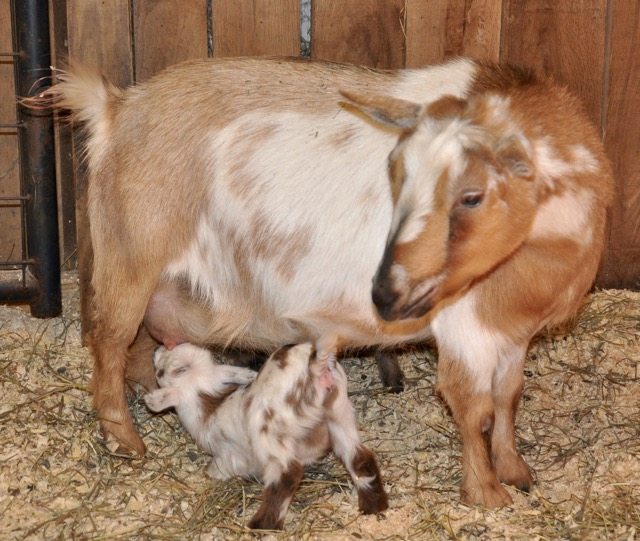
2) Dam Raising:
Another approach is to let the dams raise the kids and start milking when the kids are almost exclusively eating solid foods. Usually, the dam will quit letting them nurse (much) at between 8 to 12 weeks, and the kids are happily eating hay and grain by then (although this can vary significantly – some dams will take much longer to totally wean kids).
This approach obviously has the advantage of being less time-intensive than bottle feeding the kids; however, you have to wait a long time for that milk, the dam’s production may decrease as the kids’ consumption declines, and kids can’t leave for new homes until they’re weaned.
We unintentionally used this method once – of 8 kids born that year, only one was a doe so we only retained her. Her dam continued to let her nurse for months, and since she was the only kid, we never did separate them (couldn’t stand the screaming when she was separated) – we just milked the other dams.
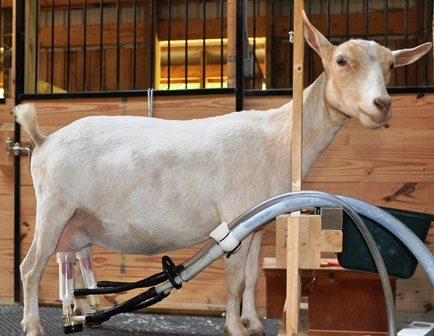
3) Dam Raising w/Separation:
Goat kids will start nibbling hay and grain at around 3 days old, and after several weeks don’t really need milk every few hours. So one common method used is that after they’re a few weeks old, the dams are separated from the kids in the morning (making sure the kids have plenty of hay and starter grain to eat, and each other to play with), the dams are milked in the evening, and then everyone is put back together for the night so the kids can nurse again.
Then, at some point the dams and kids are completely separated, milking is done twice a day, and sold kids can leave for new homes. This is the option we’ve chosen – we start separating the dams and kids during the day at 4 weeks, and fully separate them at 8 weeks. This allows us to start milk production a little sooner, the dams still get to raise the kids, kids can leave for new homes after 8 weeks, and we’re in full milk production after 8 weeks.
4) Dam Raising/Bottle Feeding:
Another approach that’s sometimes used is similar to the one above, except the kids are removed during the daytime at a much earlier age and given a bottle, but then returned to the dam at night. This allows milk production to begin even earlier (or immediately), and kids can be transferred completely to the bottle and leave for new homes as soon as they’re sold.
Some variation on this method is also sometimes used by those specifically interested in preparing their does to do well in the show ring. By removing the kids, it’s believed that the does udders “stretch” and are more impressive in the show ring.
Which Is Best?
Which of the above methods is better depends on each individual situation. And there are probably an infinite number of ways to begin getting that milk. Whatever method you choose, it should fit your situation and goals – because although goats are very productive little creatures, they should make you happy.
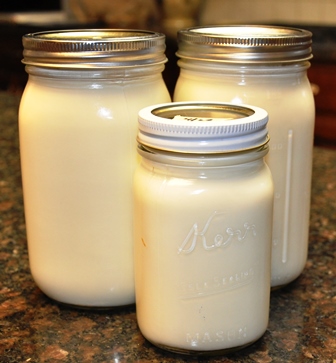
Ronald says
Thank you Lesa for your swift response. I have 100 by 150 square meters of land space that I bought in Port Harcourt, and I want to start goat farm in it. I plan on sourcing food locally to enable me to raise more goats in my farm. I want to raise the Nigerian Dwarf goat. How many can u introduce in such land space.
Ronald muench says
Good evening my dear.
I want to start a goat farm in Port Harcourt. I have only 3 plots 50/100 of land space situated at Aluu.
I have recently fenced the property. I want to know how many goats that I can raise in such space .
Lesa says
Hello Ronald, Congratulations on wanting to start a goat farm; however, from the information you’ve supplied I can’t provide advice. I’m not sure what 50/100 means and don’t know what goat breed (size) you would be getting. There is some information on pasturing goats in this article that I wrote for Hobby Farms that might be helpful: https://www.hobbyfarms.com/pasture-goats-chickens-together-for-a-dynamic-duo/?utm_medium=email&utm_source=sponsored_04_May_2021&utm_campaign=MannaPro_HF_ENews_05/04/21_Final&utm_content=20_Breeds_for_2021!
Mr Kachalla says
Hi, my name is Kachalla, please kindly assist me my goat gave birth twince and this is her first time. What type of food am l to give her to increase her milk so that her babies to be feed accordgly, please.
Lesa says
Hi Kachalla, congratulations on the twins! There is a great deal of information about what to feed them here: https://www.betterhensandgardens.com/feeding-nigerian-dwarf-dairy-goats/ There are several sections that are specific on what to feed lactating does.
Mustafa Alrjeby says
Hi, My goat gives birth just yesterday, she gave me 5 litres of milk yesterday at 3 PM, then I left her with her kid and another adult goat. Today morning at 7 am, she gave me only one litre of milk. Also I noticed that she ate less food than before.
My questions are
1. What I s the expected amount of milk she will give me in the future if I separate her kid?
2.Is the situation mentioned above is normal???
Looking forward to your reply.
Regards
Mustafa
Lesa says
Hi Mustafa, The amount of milk that a doe will produce depends on many factors such as the goat breed, genetic milk background, type of food, etc. so it’s very diffidult for me to predict how much milk she will produce. However, if you remove the kid (bottle feed it) milk her in the morning and evening every day, make sure she gets goat grain ration, feed her free-choice good hay, and keep her in good health, she should produce the maximum for her breed and genetic milk background. The situation you described doesn’t sound abnormal. Good Luck!
JJ says
I am milking a goat now but plan to breed her around October November when do I stop milking her to refreshing is it during breeding or before the babies are born
Lesa says
Hi JJ, that’s a very good question. A standard dairy animals (goat or cow) lactation is considered to be 305 days. So, after a goat or cow freshens, she is typically milked for 305 days – that means that you should definitely quit milking her two months (60 days) before she is going to freshen (give birth). So, if you bred at the end of October, you could continue to milk to the end of January. Although what I just described is considered the standard for a dairy animal, I’ve never actually milked that long. If I bred at the end of October, I usually quit milking by mid-December. I just don’t like milking in the cold weather and like to give the does a break so they can concentrate on next years kids 🙂
Lianna says
Is there any reason why I couldn’t separate the kids from the dam during the night and milk mama in the morning?
Lesa says
Hi Lianna, separating kids from the dam during the night and milking them in the morning and then putting them together for the day is the same thing as 3 described above except you’re just separating at night instead of during the day. So, there’s no reason you couldn’t do that if it fits your schedule, they’re old enough, and they’re eating well.
Jennifer A says
Thank you, Lesa! I’ve been wondering what was the best way. Our kids are four weeks now, and we’ve been separating them at night, from around 11 at night to 7 in the morning. And then leaving them together all day. This seems to be working, although with the freezing weather that’s been here this week, I’ve left them together all the time. I was worried about the babies at night. So for the past couple of mornings, we haven’t gotten any milk. I have put the girls on the milk stand and went through the motions, but those kids are greedy little things. 🙂 So now I’m wondering if they need that milk in the mornings and if I need to wait a while longer. They are all growing well, and look great. I don’t have an area that I could separate them during the day, but we have two rooms that we can separate them at night. If you have some time, could you share your advice?